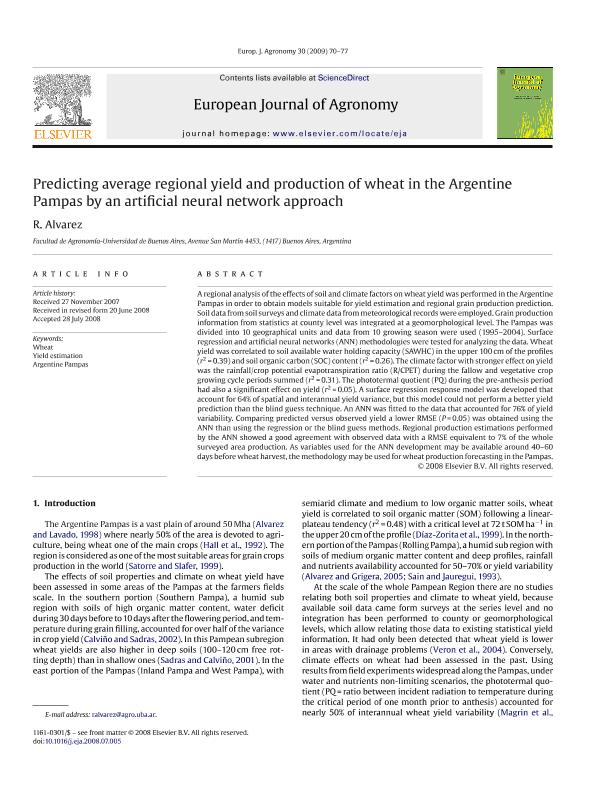Mostrar el registro sencillo del ítem
dc.contributor.author
Alvarez, Roberto

dc.date.available
2020-08-25T21:58:35Z
dc.date.issued
2009-02
dc.identifier.citation
Alvarez, Roberto; Predicting average regional yield and production of wheat in the Argentine Pampas by an artificial neural network approach; Elsevier Science; European Journal of Agronomy; 30; 2; 2-2009; 70-77
dc.identifier.issn
1161-0301
dc.identifier.uri
http://hdl.handle.net/11336/112424
dc.description.abstract
A regional analysis of the effects of soil and climate factors on wheat yield was performed in the Argentine Pampas in order to obtain models suitable for yield estimation and regional grain production prediction. Soil data from soil surveys and climate data from meteorological records were employed. Grain production information from statistics at county level was integrated at a geomorphological level. The Pampas was divided into 10 geographical units and data from 10 growing season were used (1995-2004). Surface regression and artificial neural networks (ANN) methodologies were tested for analyzing the data. Wheat yield was correlated to soil available water holding capacity (SAWHC) in the upper 100 cm of the profiles (r2 = 0.39) and soil organic carbon (SOC) content (r2 = 0.26). The climate factor with stronger effect on yield was the rainfall/crop potential evapotranspiration ratio (R/CPET) during the fallow and vegetative crop growing cycle periods summed (r2 = 0.31). The phototermal quotient (PQ) during the pre-anthesis period had also a significant effect on yield (r2 = 0.05). A surface regression response model was developed that account for 64% of spatial and interannual yield variance, but this model could not perform a better yield prediction than the blind guess technique. An ANN was fitted to the data that accounted for 76% of yield variability. Comparing predicted versus observed yield a lower RMSE (P = 0.05) was obtained using the ANN than using the regression or the blind guess methods. Regional production estimations performed by the ANN showed a good agreement with observed data with a RMSE equivalent to 7% of the whole surveyed area production. As variables used for the ANN development may be available around 40-60 days before wheat harvest, the methodology may be used for wheat production forecasting in the Pampas.
dc.format
application/pdf
dc.language.iso
eng
dc.publisher
Elsevier Science

dc.rights
info:eu-repo/semantics/openAccess
dc.rights.uri
https://creativecommons.org/licenses/by-nc-sa/2.5/ar/
dc.subject
ARGENTINE PAMPAS
dc.subject
WHEAT
dc.subject
YIELD ESTIMATION
dc.subject.classification
Silvicultura

dc.subject.classification
Agricultura, Silvicultura y Pesca

dc.subject.classification
CIENCIAS AGRÍCOLAS

dc.title
Predicting average regional yield and production of wheat in the Argentine Pampas by an artificial neural network approach
dc.type
info:eu-repo/semantics/article
dc.type
info:ar-repo/semantics/artículo
dc.type
info:eu-repo/semantics/publishedVersion
dc.date.updated
2020-07-01T17:40:15Z
dc.journal.volume
30
dc.journal.number
2
dc.journal.pagination
70-77
dc.journal.pais
Países Bajos

dc.journal.ciudad
Amsterdam
dc.description.fil
Fil: Alvarez, Roberto. Universidad de Buenos Aires. Facultad de Agronomía; Argentina. Consejo Nacional de Investigaciones Científicas y Técnicas. Oficina de Coordinación Administrativa Parque Centenario; Argentina
dc.journal.title
European Journal of Agronomy

dc.relation.alternativeid
info:eu-repo/semantics/altIdentifier/url/https://www.sciencedirect.com/science/article/abs/pii/S1161030108000865
dc.relation.alternativeid
info:eu-repo/semantics/altIdentifier/doi/https://doi.org/10.1016/j.eja.2008.07.005
Archivos asociados
